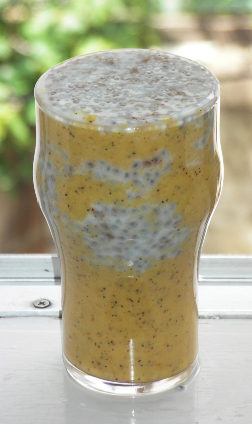
Biwa smoothie: sweet, tangy and rich
Loquats are a great early Summer fruit, with a light, sweet flavor similar to a cross between an apricot and mango. While most often enjoyed as a dessert treat, they are also used in Chinese medicine for their soothing effects. The only drawback, at least in Japan, is biwa (loquats) tend to be expensive. So I was definitely happy when I recently found a tree loaded with ripe fruit growing on public land.
In the end, I managed to collect a large bag of useable fruit. They were a little weather-scarred but tasted just fine after peeling. Some I ate straight but the majority ended up in smoothies, similar to the one you see here. Despite appearances, it is easy to make and offers a nice contrast in flavors and textures between the two liquids.
Preparation
1. Place the dried apricots in a blender, cover them with water and let them soak for around 15 minutes. You can skip this step but it helps to bring out the flavor.
2. After about 10 minutes, add one-third of the sweet basil seeds plus a little more water and let them soak for five minutes. Again, you can skip this step but it lets you see just how much the basil seeds expand (a lot).
Ingredients
• 6 large biwa (loquats)
• 1 tbspn of sweet basil seeds
• Palmful of dried apricots
• 200 g of yogurt
• Cinnamon
• Rice milk
• Honey
• Water
3. Remove the seeds from the biwa and add the fruit, three-quarters of the yogurt and the honey and cinnamon to the blender.
4. Blend these ingredients until the basil seeds are broken down into small pieces. You may need to add some more water but the final result should be fairly thick. Pour the liquid into a large glass.
5. Place the rice milk and remaining basil seeds in a separate glass. Let the whole basil seeds soak for five minutes, then add the remaining yogurt and stir the mixture.
6. When the rice milk mixture is ready, gently pour it into the first glass, taking care the liquids stay mostly separate.
Notes
I have listed sweet basil seeds in the ingredients, but use the type for Thai cooking. They can usually be found in Asian food stores. The seeds are tiny but don’t be tempted to increase the amount – they increase in size dramatically to form tapioca-like balls with a gelatinous texture. Drinks and desserts containing the seeds are popular in Thailand and other Asian countries. Most of them are quite high in sugar but the seeds themselves are very healthy – as is basil in general.
